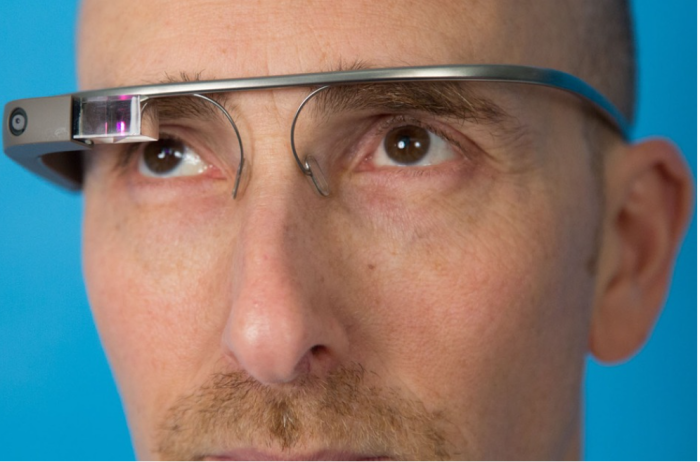Google Glass: What technology will it replace? By Linette Rasheed
Touted as the must have gadget of 2012 when Google Glass was unveiled, the technology hit the scene with a powerful force. A wearable technology that brought the digital world and physical world together, Google Glass was not also only sought after for tech-savvy consumers, but was also endorsed by the fashion industry as a must-have accessory.

Icons in the fashion world, from moguls to magazines, raised the bar and propelled Google Glass to higher status. Rocking the runway during Fashion Week 2012 in New York, models for Diane von Furstenberg glided down the stage in Google Glass as Furstenberg herself created and designed with Google Glass leading up to the show. https://youtu.be/_WVfBwCMnDE. In its September 2013 issue, Vogue followed suit and ran a spread on Google Glass.
So what is Google Glass? Goggle Glass is simply wearable technology. The wearable glasses function like a wireless computer with all the bells and whistles, hi-def camera, microphone, touchpad, display screen, and voice commands. Walking down the street and looking for the closes coffee shop, the wearer simply commands Google Glass to find the closes coffee shop and step-by step navigation is provided. Of course other features of Google Glass include video, hands-free calling, and searching the internet. Many of these features now available in other technology that allow us to communicate (smartphones) may be relics from the past if Google Glass reaches critical mass. With this in mind, Google Glass can be viewed as a disruptive technology because the task of searching for a coffee house, gas station, or directions that most consumers now use their smartphones and tablets for, can be done with Google Glass. According to Thornburg (2014a) when a technology is evolutionary, but a new technology emerges and the functions of the new technology replace the evolutionary technology, it is disruptive. And Google Glass has functions and benefits that may outpace smartphones and tablets. One in particular is the potential to open up communication for students who may otherwise shy away from class discussions. The social benefits are invaluable as students could text or email their questions to their professors who may then address questions to the entire class. In higher education specifically, the social implication for collaboration in blended instruction—students online and in the classroom, allow for the professor to open Google hangouts for all learners to participate.
CNET describes five potential benefits of Google Glass as:
- TV Enhancement—making smaller screens larger
- Biofeedback
- Face Recognition (in the future)
- Instructions
- Navigation
http://www.cnet.com/news/top-5-uses-for-google-glass/
While Google Glass is a disruptive technological force that provides the same functions of smartphones and tablets, it does not do so cost efficiently. Google Glass can costs up to three times as much as the most popular smartphones and tablets—namely Apple products. One of the primary drawbacks cited of Google Glass is the issue of privacy and protecting others’ data. Anyone walking down the street, sitting in a coffee shop, restaurant, airport, or any other public place wearing Glass can capture it all on video—recording the world with or without consent. Private moments no longer private. NY Times Writer Nick Bilton in his article Why Google Glass Broke, described the issue of privacy being systemic in Las Vegas where many casinos banned patrons from entering wearing Glass. http://www.nytimes.com/2015/02/05/style/why-google-glass-broke.html
In spite of these problems and other issues of short battery life and poor audio quality, Goggle Glass may be around for decades to come. The glasses are comfortable, portable, and highly functional. And wearable technology continues to evolve. When the bugs are worked out of the first version of Goggle Glass, other emerging technology or disruptive technology may find a contender difficult to replace.
References
Bell, D. CNET Top 5- Best uses for Google Glass. Retrieved January 17, 2016 from
http://www.cnet.com/news/top-5-uses-for-google-glass/
Bilton, N. (2015, February 4). Why Google Glass broke? New York Times. Retrieved from
http://www.nytimes.com/2015/02/05/style/why-google-glass-broke.html
DVF| Made for Glass. Retrieved January 12, 2016 from https://www.youtu.be/_WVfBwCMnDE
Google Glass. (n.d.). Retrieved June 7, 2014, from http://www.google.com/glass/start/
Laureate Education (Producer). (2014a). David Thornburg: Disruptive technologies [Video file].
Baltimore, MD: Author.
For more information on Google Glass visit: https://youtu.be/V3SAS1xpQw0
Or visit my blog at: https://eshread.wordpress.com
Hi Linette,
Thank you for this very interesting post. Do you think that Google Glass and other wearable technology can be harmful for human health?
Thank you,
Lena
Hi Lena. I suppose prolonged use of Google Glass could pose potential health risks. Viewing the display with images, text, and graphics in such close proximity without giving the eyes a break sounds dangerous. Even people who wear glasses and contacts are encouraged to take them off; however, this concept may be overlooked for eager, trendy techies. One disadvantaged I read on a forum about Google Glass suggested that drivers and cyclists should not wear GG because the glasses interfere with a person’s peripheral vision.
Thank you, Linette, for your detailed and thoughtful response.
Lena
Hi Lena. I suppose prolonged use of Google Glass could pose potential health risks. Viewing the display with images, text, and graphics in such close proximity without giving the eyes a break sounds dangerous. Even people who wear glasses and contacts are encouraged to take them off; however, this concept may be overlooked for eager, trendy techies. One disadvantaged I read on a forum about Google Glass suggested that drivers and cyclists should not wear GG because the glasses interfere with a person’s peripheral vision.